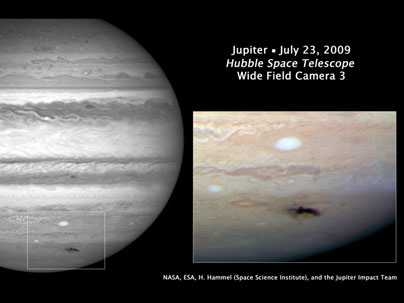Astronomers have been turning the world's most powerful telescopes toward Jupiter, the solar system's largest planet, ever since Australian amateur astronomer Anthony Wesley discovered a new dark marking on the planet, apparently the scar from an impacting asteroid or comet, on the night of July 19. MIT professor of planetary science Richard Binzel says the impact highlights the role that Jupiter, with its powerful gravitational field, plays in protecting the Earth and other planets from such impacts.
"Jupiter is the big bully of the solar system," says Binzel, who specializes in observations of asteroids and comets. But if it's a bully to some celestial objects, it's the protector of others. "Under Jupiter's influence, many objects end up being cast into the sun, some get cast out [of the solar system], and some end up striking Jupiter itself. The net result is that Jupiter keeps the inner solar system more cleaned out than it might otherwise be."
This is only the second time such impact scars have ever been seen on Jupiter, following the widely observed impacts on that planet by many fragments of the shattered comet Shoemaker Levy 9 in 1994, and suggests that such events may not be as rare as astronomers had thought.
Binzel has written extensively about the issue of impacts on planets by these smaller objects, and created the Torino Scale as a way of communicating the risk of possible impacts on Earth by newly discovered asteroids or comets. He says the discovery of this new impact is a surprise.
"We had no idea these kinds of impacts might be so frequent," Binzel says, adding that the new question is whether having two impacts on Jupiter within 15 years - after centuries of observations in which no such impacts were seen - is just a coincidence, or a result of our ever-improving ability to observe and detect such events.
Binzel also said the discovery shows the important role amateurs play in modern-day astronomy.
"Detecting these kinds of spots on Jupiter, and being sure about them, may be attributable to modern technology," Binzel says. "Amateur astronomers can now be equipped with very capable digital cameras - using CCDs, like the sensors in your pocket digital camera - that give a comparable capability to what only professional astronomers had a decade ago. Thus the capability of amateur astronomers, who play an essential role in monitoring the planets for new phenomena, means that any new event like this is almost certain to be picked up."






